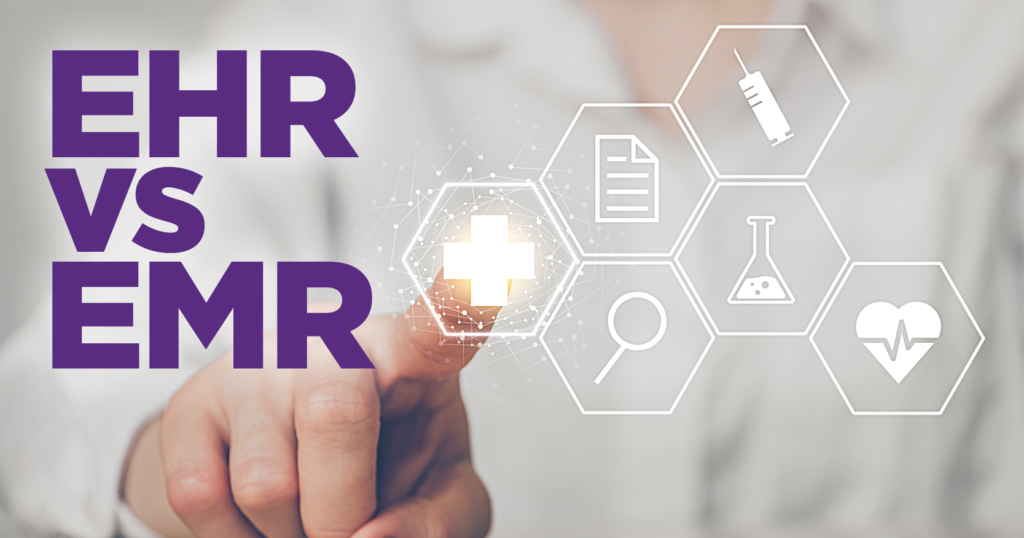What is the Difference Between EMR vs EHR?

While EMRs and EHRs Are Similar, There Are Some Key Differentiators That Can Affect Your Practice
The terms are so often used interchangeably that you might be wondering, Are EMRs and EHRs the same thing? The short answer is no, they actually are not. Even though they serve similar functions, there are a few key differences between EMRs and EHRs that should be taken into consideration when you’re choosing a new healthcare software solution for your specialty medical practice.
What’s an EMR?
EMR stands for “electronic medical record” and essentially is a digital replacement of traditional paper charts. Like old-school charts, EMRs contain the medical history of a patient’s visit, including diagnoses and treatments — at that specific practice only.
The benefits of EMRs over paper charts are many: Practices can keep better track of a patient’s information, which results in improved tracking of vital data over time, like weight and blood pressure. Electronic records also make it easier for practices to know when patients are due for regular checkups and screenings. Keeping patient charts all in one digital place can also save office space and eliminate the time and resources needed to organize physical charts.
There is one slight disadvantage of EMRs, however. If a patient’s medical history needs to be shared with another provider, it might be difficult to do so digitally. Practices may need to resort to the same method used to share information from physical paper charts: Print the patient’s data from the EMR and mail or fax it to the other provider. Of course, this also means that any additional diagnoses, treatments and medications noted by another specialist would have to be manually added to the patient’s record.
What’s an EHR?
EHR is the acronym for “electronic health record.” It sounds so similar to EMR that it’s really no wonder the two terms are often confused for each other. Many of the functions are also similar. Just like EMRs, EHRs contain patient histories, diagnoses and treatments, and may also include lab and imaging results and attached photos. But unlike an EMR that keeps the data with only one provider, an EHR moves with the patient, and the information can be instantly shared electronically with other authorized providers.
Because an EHR can contain a more complete medical history of a patient across specialist practices, ASCs and other providers, physicians may be able to make more informed decisions about their patients’ diagnoses and treatments, and in turn, patients may benefit from improved patient care.
What Are the Key Differences Between an EMR and EHR?
Both EMR and EHR systems are better alternatives to traditional paper charts. Keeping patient data in one centralized, digital location means better organization of that data, which can lead to more complete patient histories and the ability to track health data over time, which can help improve the quality of patient care. But the main difference between EMR and EHR systems is that EHRs offer portability of that patient data.
Not only can patient data be shared with and accessed by authorized healthcare providers, it can also be accessed by patients themselves. EHR systems that offer patient portals give patients visibility into their own medical histories and can even let them make their own updates regarding insurance and billing information, allergies, and medications. By letting patients view their own data, such as lab results and educational materials, specialists who leverage EHRs can encourage their patients to take a more active role in their own healthcare, which may further improve patient outcomes.
EHR systems may also offer specialist practices other advanced tools, such as integrated Practice Management systems that connect practices from end to end or analytics platforms that give practices insight into the health of their businesses.
What’s the Takeaway?
When selecting healthcare software for your specialist practice, it’s important to take all of the functions of EMRs and EHRs into account and determine which can offer your practice the most benefits. Either option will be an improvement over traditional paper charts because of the potential saving of resources such as the time spent filling out and organizing them and the space needed to store them.
EMRs and EHRs have a lot in common, but EHRs generally offer more benefits to practices and patients alike with data portability, interoperability, and additional tools and features such as practice management, revenue cycle management, patient engagement, analytics and more. Be sure to take a look at what each EHR system has to offer and select one that best suits the needs of your practice and your patients.
Learn more about ModMed®’s specialty-specific EHR and all-in-one software suite.